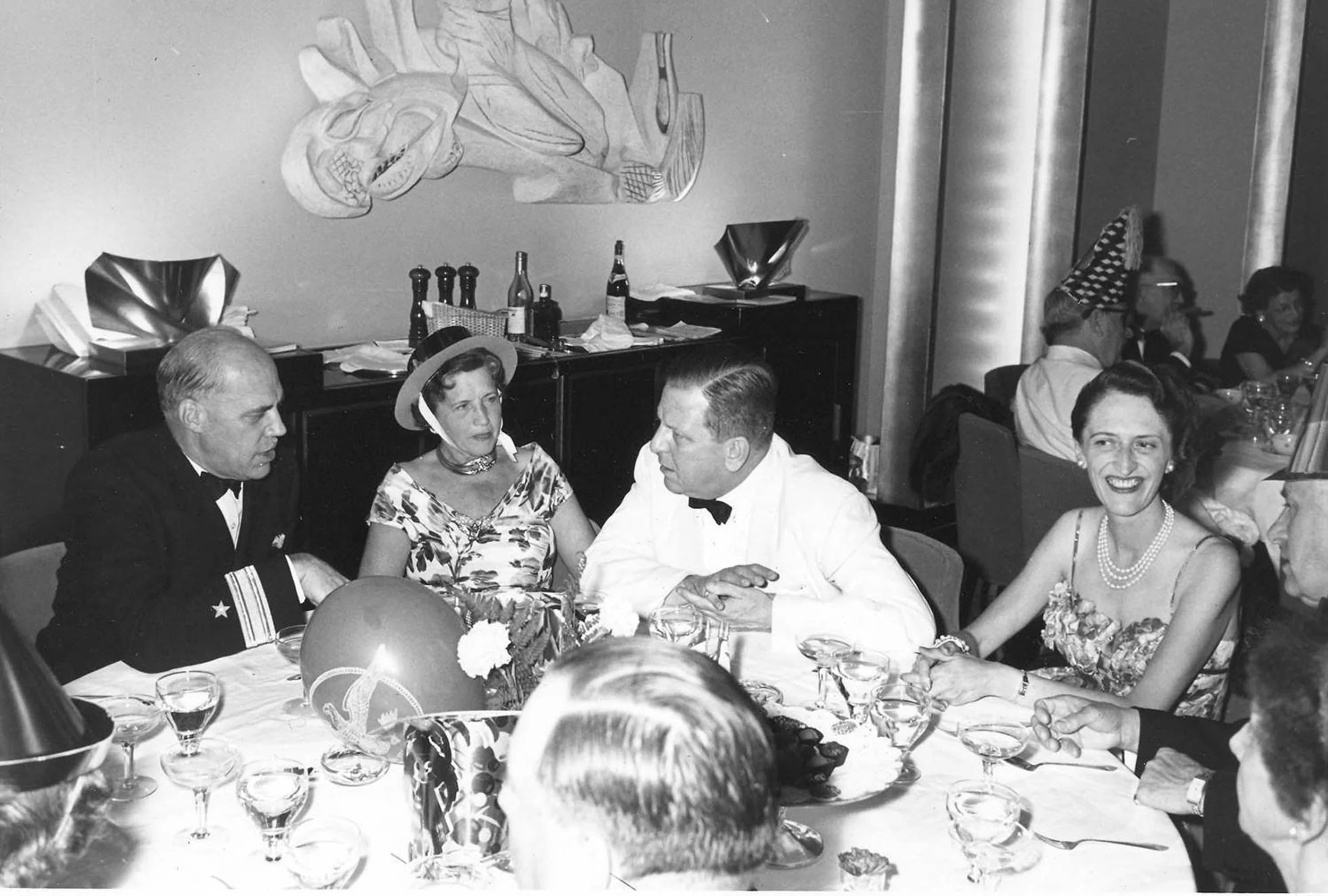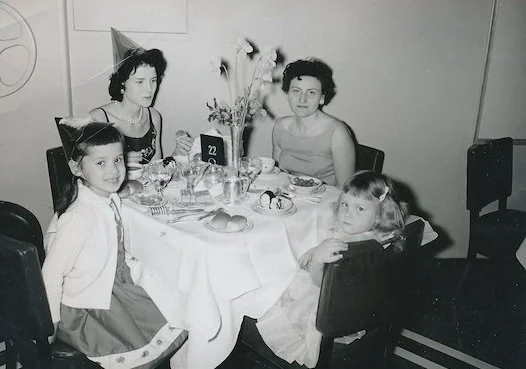FOOD TASTES BETTER AT SEA:
Dining Aboard the SS United States
Take a Seat | Setting the Table | What's on the Menu?
Innovation and Tech | Back of House | An Enduring Legacy
Guest Book | Shop
NEXT: Setting the Table
TAKE A SEAT
Dining on the SS United States was an event. Passengers were asked to wear their best dress. For ladies, this meant no shorts. For the gentleman, a jacket or coat was required. Ship photographers snapped photos of passengers as they arrived.
Passengers ate three meals a day in the various rooms, according to their class. No area of the SS United States was segregated by race. This was significant, at a time when cruel Jim Crow laws excluded Black people from many public places (especially restaurants) in America. All passenger restaurants were located on A Deck. Crew mess rooms were on B Deck. Other meals, snacks, and drinks were served in the lounges and bars. Buffets frequently lined the Promenade Deck, featuring bouillon to sip while passengers reclined on deck chairs. Passengers of all classes could order food straight to their rooms at any time of night, thanks to handy "steward" buttons located on their stateroom walls. All food was prepaid with the price of passage, much to the delight of hungry children who ordered as much food as they could imagine.
safety at sea
When the SS United States encountered stormy seas, plates and silverware were liable to fly. Following a particularly bad storm, seat belts were installed underneath the dining room chairs. Tables were equipped with raised lips around the edge, to lessen the potential shifting of dining ware. Another unusual, if not amusing, precaution was taken by waiters who poured water on the tablecloths during storms, which helped plates stick in place. Candles were not permitted on board either, so there was no chance a rogue candle would start a fire during a storm. Instead, electric wired lights illuminated the rooms.
“Yes, we had bad weather and I remember the evening meal in the dining room. The ship was rocking so bad, dishes were sliding. The waiters were telling all of us, 'Don't try to save dishes! Just hold on to the table so you don't tip over!'“
- June Sam
(1954 Tourist Class passenger)
These instructions were printed in the ship's newspaper The Ocean Press. SS United States Conservancy Collection. Courtesy of Trevor Worthington.
first class dining room
Promotional photo from a United States Lines pamphlet, often given to travel agents. SS United States Conservancy Collection. From the Mark Perry Collection.
A photo from the Captain's Table featuring Commodore Anderson (left), the longest serving captain of the SS United States. SS United States Conservancy Collection. Courtesy of Commodore Anderson's son, Charles Anderson.
This glamorous room was placed mid-ship to minimize motion. It was a wide and tall room, spanning the whole width of the ship. Navy structural requirements limited the seating capacity of the room to 390 passengers. This required two separate sittings for meals, somewhat unusual compared to other ocean liners' First Class dining rooms. The Meyer Davis orchestra performed in an alcove overlooking the room. The seating chart was devised by the Chief Steward, who frequently seated the most famous passengers in the center of the room, with the "semi-millionaires" off to the sides. This could be changed with a well-timed $20 or $50 bill. Artworks featured included Expressions of Freedom, a large foam glass assembly sculpted by Gwen Lux.
The Captain's Table is a time honored tradition in seafaring. Only the most well-connected passengers would be invited to dine with the Captain at this table located in a corner of the First Class Dining room. Frequent diners included family of United States Lines representatives, celebrities, and members of the press.
CABIN CLASS DINING ROOM
Promotional photo from a United States Lines pamphlet, often given to travel agents. SS United States Conservancy Collection. From the Mark Perry Collection.
The Abbondandolo family celebrating Gala Night in Cabin Class, during their 1953 voyage from NYC to Germany. SS United States Conservancy Collection. Courtesy of Inga Bowyer.
This restaurant was less extravagant than First Class, with lower ceilings and darker colors. However, it was still a grand dining space, with a wide center also equal to the ship's width. The center featured a stage for orchestral performances. Artworks in the room included aluminum line sculptures designed by Michael Lantz and Seymour Lipton. The most controversial artwork was undoubtedly the Taurus bull metal sculpture; when New York Times shipping news editor George Horne spied the bull's large male appendage during the ship's Sea Trials, he demanded it be removed. As the story goes, the bull's castrated organ was then put on a plaque and delivered to Horne's office. Cabin Class and First Class shared a galley, located in between the two dining rooms. Typical diners in Cabin Class included well-off professionals and their families, military families, and wealthy passengers who opted not to travel First Class.
tourist class dining room
This photo was featured in the 1984 Guernsey's Auction catalog. Few color photos of the Tourist Class Dining room were taken. SS United States Conservancy Collection.
Photo of the Jones family celebrating Gala Night in Tourist Class. Pictured include Sonja Jones, age 6, and mother Sonja Jones, age 27. SS United States Conservancy Collection. Courtesy of Sonja Jones.
This room was the least extravagant space of the three classes. The Tourist Class dining room was wedged between the Tourist Class galley to the left, and Tourist Class staterooms to the right. The dining room could seat up to 340 passengers, at large rectangular tables. The room featured murals depicting 18th century nautical icons by Erica Egan. A diner in Tourist Class could expect to hear a number of languages over meals, thanks to the many students traveling to study abroad, and immigrants traveling to their new homes.
SPECIAL RESTAURANT
Special Restaurant, featuring Tissot’s panels on the right and center. SS United States Conservancy Collection. Courtesy of Robert G. Lenzer.
“Snowflake Crystal Montage”, Charles Lin Tissot. SS United States Conservancy Collection, donation made possible by Bob Forbes, Mark Perry, Carl Wesch, Mario Alvarez-Garcillan, Susan Gibbs, Charles Anderson, Frank Slate Brooks.
Located on the Promenade Deck, next to the Grand Ballroom, this restaurant was known as the Restaurant, the Special Restaurant, or the First Class Grill. It was an intimate, reservations-required room that sat 50 passengers (only .04% of First Class!). Celebrities like the Duke and Duchess of Windsor would request tables here to dine privately, away from the prying eyes of other passengers. The Special Restaurant was accented by large aluminum-mounted backlit crystal light panels, designed by Charles Lin Tissot. The panel featured 17 individualized cut crystal stars (or snowflakes) set in perforated aluminum; the Conservancy is grateful to have one of these panels in our collections. Many ocean liners offered small à la carte restaurants, complete with special menus tailored for their elite passengers. Uniquely, this restaurant served the exact same menu as the First Class Dining Room.








